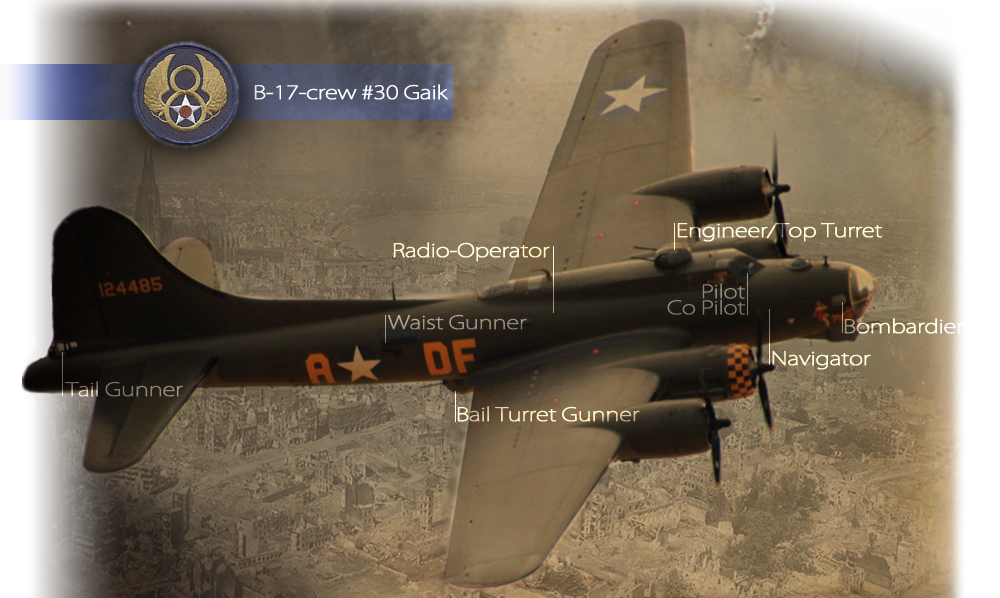[:us]
Bombardier/Togglier:
The basic principle of any bombing mission was to deliver the bombs accurately on the target. To navigate through clouds or to evade and counter the enemy’s defenses was an achievement in itself, yet everything depended upon the bombardier’s ability to hit his target. The bombardier’s main tool was the Norden bombsight, a top secret piece of equipment the Allies guarded throughout the war. On a mission, the bombardier’s real job began at the IP. This was the point at which the bombing run on the target began; from this point on, the bombardier would fly the airplane through the bombsight linked to the autopilot. The plane would have to be flown straight and level to the release point through flak and fighter attacks. Few, if any, bombers equalled the B-17 in visibility afforded to the bombardier. Sitting behind the bombsight in the plexiglas nose gave him an unrestricted view for his mission. The Norden simplified the bombardier’s job considerably by taking into account factors of altitude, airspeed, ground speed and drift to automatically calculate the bomb release point.
The optical sighting mechanism of the bombsight was a small telescope. The bombardier would first locate the target by looking over the instrument and through the plexiglas nose. Once the target was located he would try to line it up in the telescope, often requiring several head up glances to find the target again. There were two cross hairs on the telescope, one to show drift left or right of the target, the other to show rate of closure. When the two indicators met the bomb would automatically release.
Originally the bombardier had a .30 caliber machine gun in the plexiglas nose but this was soon changed to a more effective .50 caliber. In late 1943, a powered chin turret was added to help combat frontal attacks and became standard equipment on the B-17G.
The difference between a Bombardier and a Togglier is the fact that a Bombardier is always an officer who also could become the Leader of a group or a mission (Lead-Bombardier); a Togglier was always an enlisted men who had to drop the bombs at the same time the Lead Bombardier did so. A Togglier wasn’t alloowed to make the decision on his own.
| Cohen, Joseph nmi
1stLT |
Bombardier/Togglier |
|
KIA 31-12-1944 (in crew # 35 Monit) |
| Hamlin, Alan P
T/Sergeant
|
Bombardier/Togglier
|
|
WIA 31-12-1944
|
| Freund, Norman H
1stLT
|
Bombardier/Togglier
|
|
|
| Cahill, George F
Staff Sergeant
|
Bombardier/Togglier2 missions ( 232 and 233) as Waist gunner in crew # 28
|
|
|
| Weldon, King M | Bombardier/Togglier |
POW Feb-14-1945 Died July-29-1967
|
[:nl]
Bombardier/Togglier:
Het basisprincipe van een bommissie was om de bommen doeltreffend te droppen op het doel. Het navigeren door wolken of het ontwijken en bestrijden van vijandelijke verdediging was al een prestatie op zichzelf, maar alles hing af van de kwaliteit van de Bombardier om het doel exact te treffen. Het belangrijkste instrument van de Bombardier was de “Norden bombsight”, een topgeheim hulpmiddel dat door de Gealieerden gedurende de oorlog streng werd bewaakt. Tijdens een missie begon de echte taak van de Bombardier bij de IP. IP is de afkorting van Initial Point, dit is het eerste punt op de vlucht kaart waar de “Bomb Run” start. Vanaf dit punt loodst de Bombardier het vliegtuig gekoppeld aan de automatische piloot door de Norden Bombsight. Het vliegtuig diende recht en op een vaste hoogte gevlogen te worden tot aan het doel dwars door vijandig luchtafweer en vijandelijke aanvallen van jachtvliegtuigen. De Bombardier had al zittend achter de Norden Bombsight in de plexiglas neus een onbelemmerd zicht voor zijn missie. De Norden Bombsight vereenvoudigde de taak van de Bombardier aanzienlijk door rekening te houden met factoren als hoogte, vliegsnelheid, grondsnelheid en drift om automatisch het punt van bommen droppen te berekenen.
Het optische waarnemingsmechanisme van de Bombsight was een kleine telescoop. De bombardier bepaalde eerst het doelwit door over het instrument te kijken en door de plexiglas neus. Als het doelwit gelokaliseerd was probeerde hij het uit te lijnen in de telescoop; vaak was het noodzakelijk om meerdere keren kijken voordat dit uiteindelijk lukte. Er waren 2 draadkruizen op de telescoop. Op het moment de 2 indicatoren elkaar raken werden de bommen automatisch gedropt.
Aanvankelijk had de Bombardier de beschikking over een .30 kaliber geschut in de plexiglas neus, maar dit werd al snel vervangen door een meer effectief .50 kaliber zoals elders in het vliegtuig. Eind 1943 werd er nog een krachtige “Chin Turret” in de neus gemonteerd om nog krachtiger en effectiever een frontale aanval van jachtvliegtuigen te bestrijden. Vanaf dat moment werd dit standaard in de B-17G versie.
Het verschil tussen een Bombardier en een Togglier is dat een Bombardier een officier was die ook de leiding (Lead-Bombardier) over een missie kon krijgen; een Togglier was een dienstplichtige die de bommen liet vallen op teken van de (Lead-)Bombardier. Zelfstandig mocht hij die beslissing niet nemen.
| Cohen, Joseph nmi
1stLT |
Bombardier/(Togglier) |
|
KIA 31-12-1944 (in crew # 35 Monit) |
| Hamlin, Alan P
T/Sergeant |
(Bombardier)/Togglier
|
|
WIA 31-12-1944
|
| Freund, Norman H
1stLT
|
Bombardier/(Togglier)
|
|
|
| Cahill, George F
Staff Sergeant
|
(Bombardier)/Togglier2 missies ( 232 en 233) als Waist gunner met crew # 28
|
|
|
| Weldon, King M | (Bombardier)/Togglier |
|
POW 14-02-1945
Gestorven 29-07-1967
|

